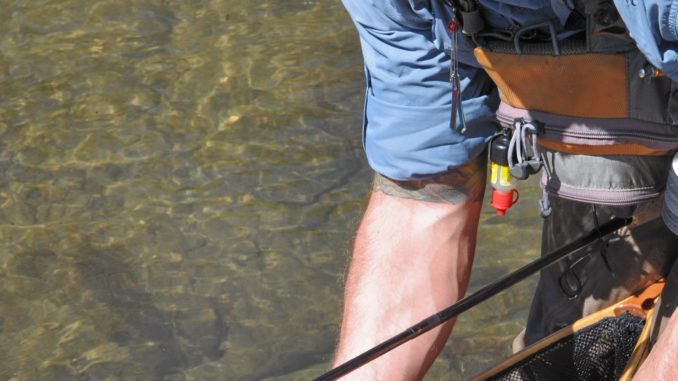
Tenkara is a simple-to-learn, effective and kid-friendly way to catch trout in North Carolina streams.
Learning to use a fly rod can be complicated and time-consuming, especially for younger anglers. But Lance Milks of Greensboro has important a Japanese technique for putting artificial flies in front fish that’s easy to master and a kid-friendly introduction to fishing.
“It’s called ‘tenkara,’ ” Milks said. “It doesn’t require a reel, and kids or adults can learn to cast flies in a few minutes. Kids just starting can experience the thrill of catching bluegills at farm ponds, which is how most people learn to fish with a cane pole and a bobber. Then they might move on to mountain trout.”
A tenkara rig looks like cane-pole fishing to most fishermen, but it’s definitely more high-tech and extremely effective.
A tenkara rod presents flies to fish, especially spooky mountain trout, in small to medium-sized streams. Once anglers learn tenkara — a Japanese word that means “from heaven” or “from the skies” — it won’t be long before they’re ready to challenge trout.
“I discovered it by accident,” said Milks, 34, a former U.S. Marine who began fishing at age 7. “I was stationed in Japan for more than a year, but I didn’t learn about tenkara until I came home.”
Milks, who manages the firearms section at Greensboro’s Gander Mountain and does some guiding for mountain trout, said tenkara fishing was invented in Japan about 200 years ago. It first appeared in San Francisco in 2009, and it spread quickly from there — including back to Japan.
“The Japanese love American recreational activities,” Milks said. “It had been mostly forgotten in Japan until it became popular at our west coast.”
It took a few years to spread to America’s eastern and southern states with freshwater trout. Early on, noted fly fisherman and outdoor writer Lefty Kreh called tenkara a “fad” but later apologized for his evaluation after the technique caught fire.
Milks discovered tenkara while looking for fly-fishing tackle to reduce weight in his hiking backpack. A hiking website led him to tenkara, and he immediately added tenkara equipment.
“Tenkara outfits weigh eight ounces, including a plastic container to hold flies,” said Milks (910-729-7089), who described rods that telescope down to 20 inches and come with 15 feet of pre-loaded, level line; put in kit bags, they easily attach to loops on the sides of backpacks..
“It’s hard to carry a traditional fly rod into some places because rods may snag on limbs or twigs or even jam the tip into the ground,” Milks said. “With a tenkara rod, you don’t worry. When you find a stream you want to fish, you just extend the rod, tie on your fly, and you’re ready to fish. They telescope out to 12 feet on average, but you can get ones that extend from 8-foot-10 to 14-foot-7.”
Fishing for trout with a tenkara rod is similar to using a traditional fly rod, except there is no reel. A tenkara outfit uses two types of line tied together — level or tapered line, then 3 to 4 feet of tippet, with 5x or 6x size recommended. The line is tied to the rod tip, then a fly or tandem flies .
“I like to use a larger floating fly, such as an Elk Hair caddis, as a (strike) indicator for the sinking nymphs,” Milks said.
Tenkara anglers may look for trout by walking along stream banks or wading. Either way, the main idea is to avoid spooking fish.
“You need a good pair of polarized glasses to spot trout,” Milks said. “The thing I like most about tenkara is it’s usually sight-fishing. You spot a trout and have to decide how you’ll approach him, cast the fly above him at the right spot to let it drift in front of him, then be quick enough to react and set the hook if he attacks the fly.”
Anglers wading move slowly upstream and cast to fish or likely spots, then watch for line jerks. Trout often blast dry flies or explode out of the water as soon as a lure touches the surface. If a smaller trout takes a lure, it’s best to work the fish by lifting the rod tip after the fish tires. If it’s a large trout, walk with the fish until it tires, keeping tension on the line. When the fish tires, slowly lift the rod tip to move it closer to net. A landing net is a necessity.
“Shorter rods are good for fishing tight streams with overhanging canopies,” Milks said. “If you’re fishing more open water, you can use a longer rod. Some tenkara rods extend two or three lengths out to 14 ½ feet.”
Tenkara casts move the rod tip overhead and quickly enough to allow line to flow behind the angler. A forward cast moves line and a fly toward the target.
“It isn’t difficult,” Milk said. “It only takes a few minutes to learn.”
The basic concept is similar to traditional fly-casting, which involves lifting the rod tip back quickly to get the line behind the angler’s head, then stopping the rod to create flex in the tip. Then move the rod tip forward and down to cast the line, stopping parallel to the water as the fly shoots toward the target.With a 10-foot rod and a slightly longer line length, an angler can cover more than 20 feet of water, which is perfect for small streams.
“The rod and line are so light, casting won’t wear you out,” he said. “Usually, it only takes one or two back casts. The key to accuracy is putting your index finger on top of the rod handle and pointing that finger at your target. It takes a little practice to build up confidence and get the feel of how to cast, but it’s not hard to learn.”
Traditional tenkara flies are called sakasa kabari, but Milks uses them only occasionally. Backward-facing hackles are part of sakasa kabari flies distinctive design. He prefers traditional flies such as the Elk Hair caddis, Parachute Adams and bead-head nymphs.
Milks splits his leisure time between hiking and hiking to fish mountain streams for trout.
“I usually stick to the northwestern corner of the state and fish trout streams up there,” he said. “It’s great for remote streams where trout aren’t pressured. If I want to do back-country fishing, I’ll drive into the Great Smokies and walk to pristine waters. But North Carolina also has a lot of great delayed-harvest trout streams. I’ve also fished for brookies, brown and rainbow trout, where all three have been stocked. Delayed-harvest streams are great for landing an Appalachian slam (brown, brook and rainbow).”
Milks and his clients have hooked trout as long as 24 inches. Large rainbows or browns offer a challenge to land with tenkara rods.
“I’m a 100-percent catch-and-release guy, so I don’t keep mountain trout, even if I’m fishing a stream where it’s allowed,” Milks said.
When a fisherman with a tenkara rod hooks a large trout, Milks urges them to calm down then fight the fish properly.
“A tenkara rod can handle fish that size,” said Mills, who has had clients become proficient enough with a tenkara rod after 15 minutes of practice to hook and land mountain trout.
“There’s something about taking a person out and having them hook their first trout,” he said. “It kind of validates you as a fly fisherman that you know what you’re doing.”

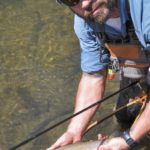
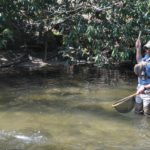
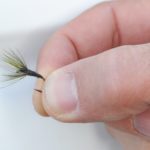
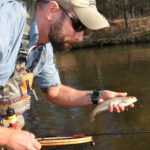


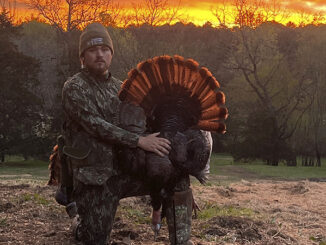

Be the first to comment